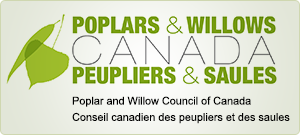The following statistical information has been extracted from the Canadian reports to the 24th (2012), 25th (2016) and 26th (2020) Sessions of the International Poplar Commission. For more information and background material on the research and utilization of poplars and willows in Canada, readers may read the full reports, which are available on this site: IPC Canada Country Report 2008-2011
Canada is a forest country.
Canada has 10 percent of the world’s forests that cover 397.3 million hectares (ha) of forest, other wooded land and other land with tree cover, which represents 53.8 percent of its total surface area. Canada’s forest, other wooded land and other land with tree cover are made up of 347.7 million ha (87.5 percent) of forest, 41.8 million ha (10.5 percent) of other wooded land and 7.8 million ha (2 percent) of other land with tree cover. The predominant tree species on forest land are spruce (53.2 percent), poplar (11.6 percent) and pine (9.3 percent). The vast majority of the Populus inventory in Canada consists of natural stands.
Areas of natural poplar and willow
Areas (in 1000s of hectares) of natural poplars and willows by species and ecozone, based on the 2006 National Forest Inventory. P = Populus (poplar); S = Salix (willow). (see https://nfi.nfis.org/en and Natural Resources Canada, Canadian Forest Service.)
| Ecozone | P. tremuloides | P. grandidentata | P. deltoides | P. balsamifera | P. trichocarpa | P. species | S. species | Total |
| Atlantic Maritime | 1,120 | 9 | 14 | 73 | 1,216 | |||
| Boreal Cordillera | 1,577 | 136 | 1,713 | |||||
| Boreal Plains | 15,332 | 745 | 32 | 0.8 | 16,110 | |||
| Boreal Shield | 3,917 | 97 | 12,161 | 9 | 16,184 | |||
| Hudson Plains | 8 | 95 | 103 | |||||
| Mixedwood Plains | 61 | 8 | 0.2 | 11 | 61 | 10 | 151 | |
| Montane Cordillera | 1,228 | 129 | 7 | 1.5 | 1,366 | |||
| Pacific Maritime | 85 | 58 | 15 | 158 | ||||
| Prairies | 1,775 | 700 | 2,475 | |||||
| Taiga Cordillera | 10 | 10 | ||||||
| Taiga Plains | 4,031 | 103 | 4,134 | |||||
| Taiga Shield | 1,152 | 28 | 1.180 | |||||
| TOTAL | 30,296 | 114 | 0.2 | 1,924 | 22 | 12,424 | 19.8 | 44,800 |
Reported areas of hybrid poplar in short rotation intensive culture
Hybrid poplar is a term normally applied to clonal selections of poplar used for plantings, including windbreaks, fibre plantations, buffers or phytoremediation. Poplar hybrids are created by purposely crossing compatible poplar species in the Aigeiros (cottonwood) section and the Tacamahaca (Balsam poplar) section. Many hybrids have P. deltoides as one of the parents.Other parents commonly found in hybrid poplar include P. trichocarpa, P. balsamifera, P. nigra, P. xpetrowskiana and P. maximowiczii. See the clonal database for details of many of these clones.
Fast-growing plantations of various poplar hybrids have been planted by industry - mostly on private land - for wood or pulpwood as a fast-growing source of fibre, known as Short-Rotation Intensive Culture (SRIC) (or Short-Rotation Woody Culture - SRWC). The table below shows areas of SRIC in Canada as reported by various companies.
| Operator | Planted 2004-7 | Total crops to 2007 | Planted 2008-11 | Reported total for 2011 |
| hectares | hectares | hectares | hectares | |
| Kruger Products Ltd., BC | 70 | 1,070 | 123 | 3,411 |
| Catalyst Paper Corp., BC | 0 | 200 | 0 | Unknown |
| Alberta-Pacific Forest Ind., AB | 4,940 | 5,640 | 4,000 | 9,000 |
| Ainsworth Engineered, AB | 215 | 215 | 390 | 605 |
| Agriculture & AgriFood Canada, SK | Unknown | 9,030* | 1,470* | 10,500* |
| Domtar Inc., QC | 0 | 2,500 | suspended | 4,000 |
| Agro Energie Inc., QC | 43 | |||
| MRNF, QC | 200 | 350 | 0 | Unknown |
| TOTAL | 5,425 | 19,005 | 5,983 | 27,559 |
*Areas reported by Agriculture & AgriFood Canada are mainly for adapted clones planted as shelterbelts in the prairie provinmces.
Hybrid poplar in Québec
In Québec, approximately 12,000 ha of SRIC are industrially managed, while private landowners have planted 1000 ha. Most of these poplar plantations are established on clearcut forest sites. Yields as high as 39.6 m3ha-1year-1 were observed in a 6-year-old riparian system in southern Québec. Yields of 22.4 m3ha-1year-1 were measured in an 8-year-old SRIC plantation on abandoned farmlands in the Montérégie region and 16.6 m3ha-1year-1 after 6 years in the Lanaudière region. On the other hand, low yields of 0.5 to 1.4 m3ha-1year-1 were harvested from four hybrid poplar plantations. See also Fortier, J. et al. 2012. Hybrid poplar yields in Quebec: Implications for a sustainable forest zoning management system. The Forestry Chronicle 88(4):391-407.


